1.Introduction
High amplitude δ Scuti stars, hereafter HADS, constitute a very small percentage
(< 1%) of all δ Sct variables (Lee et al.
2008). They commonly oscillate (
An additional classification scheme for δ Scuti stars was recently examined by Qian et al. (2017). Therein two distinct groups
of δ Scuti stars were uncovered from the LAMOST survey (Zhou et al. 2009) that fundamentally differed in effective
temperature. One group was identified as normal δ Scuti stars (NDSTs) when
Teff ranged between 6700-8500 K while the other was considered as
unusual and cool variable stars (UCVs) with Teff values less than 6700 K.
A more restrictive fundamental pulsation range (0.09-0.22 d) coupled with being
slightly metal poor (
The variability of CSS J051053.0+071722 (J2000-05:10:53.0976 +07h 17m 21.984s; l=194.1681 b= -18.49118) was first recorded in unfiltered photometric data (also known as NSVS 9510981 and NSVS 12312737) collected during the ROTSE-I Survey (Akerlof et al. 2000). These sparsely sampled lightcurve (LC) data collected between 1999-2000 can be retrieved from the Northern Sky Variable Survey1 (Woźniak et al. 2004). More robust supporting evidence used to establish the primary oscillation period of this intrinsic variable (CSS J051053.0+071722) was gathered between 2001-2009 during the Catalina Sky Survey2 (Drake et al. 2009). Its variability was also identified from an evaluation of photometric data (also known as ASAS J051053+0717.4) collected (2005-2013) during the All Sky Automated Survey3 (Pojmanski 2000). This report marks the first multi-color photometric study of CSS J051053.0+071722 which also describes the physical nature of this radial pulsator and critically assesses its classification as a HADS variable.
2.Observations and Data Reduction
Time-series images were acquired at Desert Blooms Observatory (DBO, USA - 110.257 W, 31.941 N) with an STT-1603ME CCD camera (Diffraction Limited) mounted at the Cassegrain focus of a ACF-Cassegrain telescope. This telecompressed (0.62x) f/6.8 instrument produced an image scale of 1.36 arcsec/pixel (bin=2x2) and a field-of-view (FOV) of 11.6´x 17.3´. Image acquisition (75-s) was performed using TheSkyX Pro Version 10.5.0 (Software Bisque). The CCD-camera is equipped with B, V and Ic filters manufactured to match the Johnson-Cousins Bessell prescription. Dark subtraction, flat correction and registration of all images collected at DBO were performed with AIP4Win v2.4.0 (Berry & Burnell 2005). Instrumental readings were reduced to catalog-based magnitudes using the AAVSO Photometric All-Sky Survey (APASS) star fields built into MPO Canopus v10.7.1.3 (Minor Planet Observer). LCs for CSS J051053.0+071722 were generated using an ensemble of five non-varying comparison stars. The identity (HST Guide Star Catalog, Version GSC-ACT), J2000 coordinates and APASS color indices (B -V) for these stars are provided in Table 1. Data from images taken below 30o altitude (airmass >2.0) were excluded. Given that all program stars share the same FOV, differential atmospheric extinction was ignored. During each imaging session comparison stars typically stayed within ±0.009 mag for the V and Ic filters and ± 0.018 mag for the 𝐵 passband. All relevant lightcurve data (HJD, APASS magnitude, err, filter) acquired during this study at DBO can be retrieved from the AAVSO archives (https://www.aavso.org/data-download).
TABLE 1 ASTROMETRIC COORDINATES (J2000), V -mag AND COLOR INDICES (B - V )*
| FOV ID | GSC ID | R.A. h m s | Dec. Deg m s | APASSa V-mag | APASSa (B-V) |
| T | 0111-02001 | 05 10 53.0976 | +07 17 21.984 | 12.78 | 0.24 |
| 1 | 0111-02132 | 05 10 59.3688 | +07 21 42.876 | 12.02 | 0.62 |
| 2 | 0111-01355 | 11 21.609 | +07 14 17.520 | 13.28 | 0.48 |
| 3 | 0111-00631 | 10 56.5632 | +07 14 54.780 | 12.81 | 0.66 |
| 4 | 0111-00973 | 10 47.2464 | +07 13 40.764 | 14.28 | 0.56 |
| 5 | 0111-01041 | 10 22.4184 | +07 15 31.572 | 13.06 | 0.64 |
*For CSS J051053.0+071722 (GSC 0111-02001) and five comparison stars (1-5) used during this photometric study. aV -mag and (B - V ) derived from APASS DR9 database.
Period folded (0.0689193 ±0.0000006 d) LCs for CSS J051053.0+071722 produced from photometric data obtained between 25 Dec 2018 and 25 Jan 2019 at DBO. LCs shown at the top (I c ), middle (V) and bottom (B) represent catalog-based (APASS) magnitudes determined using MPO Canopus. The color figure can be viewed online.
3. Results
Photometric values in B (n=249), V (n=262), and Ic (n=263) passbands were each processed to produce LCs that spanned 30 d between 25 Dec 2018 and 25 Jan 2019 (Figure 2). Time-of-maximuum (ToMax) estimates (Table 2) were derived using the polynomial extremum fit utility featured in Peranso v2.6 (Paunzen & Vanmunster 2016). In this case a mean period solution for all passbands (0.068921 ± 0.000007 d) was obtained using the Fourier curve fitting utility (Harris et al. 1989, FALC) featured in MPO Canopus v10.7.1.3. Thereafter, period determinations of survey data (NSVS, ASAS and CSS) were performed using Peranso v2.6 by applying periodic orthogonals to fit observations, and analysis of variance to assess fit quality. Folding together the sparsely sampled survey data revealed a period at 0.068919 ±0.000024 d (Figure 3). The ASAS photometric data acquired in 2003-2009 were period-folded and reached superimposition when P=0.068920 ± 0.000024 d (Figure 4). Finally, unfiltered CCD data mined from the Catalina Sky Survey (CSS) were similarly evaluated (Figure 5) to produce a fundamental period of P=0.068919 ± 0.000036 d. Since no ToMax data for this variable star were found in the literature only new maxima (n=36) from DBO which appear in Table 2 were used to analyze fundamental pulse period timings (PPT). PPT differences 𝑣𝑠. cycle number (Table 2) can be described by a straight line relationship from which a new linear ephemeris was calculated (equation 1):
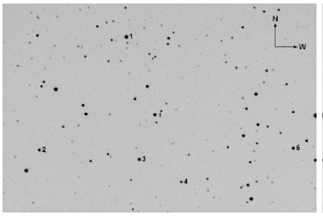
Fig. 1 FOV (17.3 × 11.6 arcmin) containing CSS J051053.0+071722 (T) along with the five comparison stars (1-5) used to reduce time-series images to APASS-catalog based magnitudes.
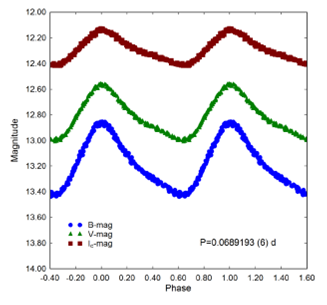
Fig. 2 Period folded (0.068919 ±0.000024 d) LCs for CSS J051053.0+071722 produced with sparsely sampled data (NSVS 9510981 and NSVS 12312737) from the NSVS (1999-2000) Survey. Precise time-series 𝑉-mag data acquired at DBO (2018-2019) are superimposed for direct comparison with ROTSE-I magnitudes which have been offset to conform to the DBO-derived values. The color figure can be viewed online.

Fig 3 Period folded (0.068919 ±0.000024 d) LCs for CSS J051053.0+071722 produced with sparsely sampled data (NSVS 9510981 and NSVS 12312737) from the NSVS (1999-2000) Survey. Precise time-series V-mag data acquired at DBO (2018-2019) are superimposed for direct comparison with ROTSE-I magnitudes which have been offset to conform to the DBO-derived values. The color figure can be viewed online.
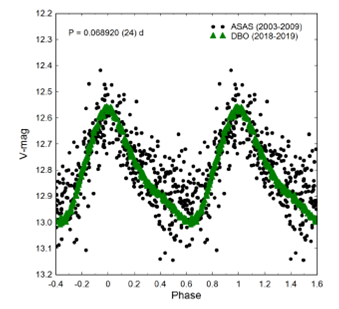
Fig 4 Period-folded (0.068920 ±0.000024 d) LCs for CSS J051053.0+071722 produced with photometric data (ASAS J051053+0717.4) from the ASAS survey (2003-2009). Precise time-series V-mag data acquired at DBO (2018-2019) are superimposed for direct comparison with ASAS magnitudes (I-band: Schott RG-9) which have been offset to conform to the DBO-derived values. The color figure can be viewed online.
TABLE 2 TIMES OF MAXIMUM FOR CSS J051053.0+071722*
| ToMaxa | Uncertainty | Filter | Cycle No. | PTD |
| 58477.6910 | 0.0006 | V | 0 | 0.0000 |
| 58477.6911 | 0.0006 | B | 0 | 0.0001 |
| 58477.6916 | 0.0013 | Ic | 0 | 0.0006 |
| 58477.7597 | 0.0007 | V | 1 | -0.0002 |
| 58477.7598 | 0.0005 | B | 1 | -0.0001 |
| 58477.7603 | 0.0011 | Ic | 1 | 0.0004 |
| 58477.8279 | 0.0014 | V | 2 | -0.0010 |
| 58477.8293 | 0.0007 | B | 2 | 0.0004 |
| 58477.8307 | 0.0008 | Ic | 2 | -0.0010 |
| 58483.6180 | 0.0006 | B | 86 | -0.0001 |
| 58483.6181 | 0.0007 | V | 86 | 0.0001 |
| 58483.6182 | 0.0012 | Ic | 86 | 0.0002 |
| 58483.6866 | 0.0007 | V | 87 | -0.0004 |
| 58483.6869 | 0.0005 | B | 87 | -0.0001 |
| 58483.6874 | 0.0012 | Ic | 87 | 0.0004 |
| 58483.7558 | 0.0009 | V | 88 | -0.0001 |
| 58483.7560 | 0.0005 | B | 88 | 0.0002 |
| 58483.7566 | 0.0010 | Ic | 88 | 0.0007 |
| 58483.8235 | 0.0008 | Ic | 89 | -0.0013 |
| 58483.8243 | 0.0006 | B | 89 | -0.0005 |
| 58483.8244 | 0.0009 | V | 89 | -0.0004 |
| 58486.6506 | 0.0009 | V | 130 | 0.0001 |
| 58486.6508 | 0.0006 | B | 130 | 0.0003 |
| 58486.6516 | 0.0011 | Ic | 130 | 0.0011 |
| 58487.6152 | 0.0008 | V | 144 | -0.0001 |
| 58487.6155 | 0.0005 | B | 144 | 0.0001 |
| 58487.6157 | 0.0008 | Ic | 144 | 0.0004 |
| 58487.6837 | 0.0013 | Ic | 145 | -0.0006 |
| 58487.6839 | 0.0006 | B | 145 | -0.0004 |
| 58487.6843 | 0.0008 | V | 145 | 0.0000 |
| 58508.6359 | 0.0005 | B | 449 | 0.0002 |
| 58508.6359 | 0.0008 | V | 449 | 0.0002 |
| 58508.6362 | 0.0011 | Ic | 449 | 0.0005 |
| 58508.7044 | 0.0005 | V | 450 | -0.0003 |
| 58508.7046 | 0.0003 | B | 450 | -0.0001 |
| 58508.7049 | 0.0006 | Ic | 450 | 0.0003 |
*Uncertainty, filter, epoch and fundamental pulsation timing differences (PTD) used to calculate a new linear ephemeris.
aAll values acquired at DBO (2018-2019).
These results along with the LCs from DBO (Figure 2), (Figure 3), ASAS (Figure 4) and CCS (Figure 5) also reveal that the fundamental pulsation period has been consistent since 1999. Due to the short duration (30 d) of available ToMax timings no attempt was made to evaluate any underlying secular changes in period.

Fig 5 Period folded (0.068919 ±0.000036 d) LCs for CSS J051053.0+071722 produced with unfiltered CCD-derived photometric data (2005-2013) from the CSS archives. Precise time-series V-mag data acquired at DBO (2018) are superimposed for direct comparison with the CSS data which have been offset to conform to the DBO-derived values. The color figure can be viewed online.
3.1.Light Curve Behavior
Morphologically, LCs of HADS variables are asymmetrical with rapid brightening to
produce a sharply defined maximum peak. Thereafter a slower decline in magnitude
results in a broad minimum. The largest difference between maximum and minimum
light is observed in the blue passband (
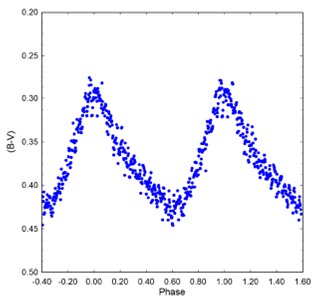
Fig 6 CSS J051053.0+071722 LC illustrating significant color change as maximum light slowly descends to minimum light (ECUACIONmag). This effect is most closely associated with a decrease in the effective surface temperature during minimum light. The color figure can be viewed online.
Interstellar extinction was obtained according to Amôres & Lépine (2005)
4 which requires galactic
coordinates (l, b) and distance (kpc). Accordingly, the Model A reddening value
(E(B-V )= 0.065 ± 0.003 mag), corresponds to an intrinsic color index (B -
V)0 for CSS J051053.0+071722 that varies between 0.239 ± 0.013
mag at maximum light and 0.350 ± 0.013 at minimum brightness. Easy access to
accurate distances from the Gaia mission (Brown
et al, 2018) offers an advantage over the dust maps generated by
Schlegel et al. (1998) and later adjusted by Schlafly and Finkbeiner (2011) wherein extinction is based on total
dust in a given direction without regard to the target distance. This often
leads to an overestimation of the reddening within the Milky Way galaxy, most
commonly determined as E(B-V)=AV/3.1. The average effective
temperature (Teff) was estimated to be 7222 ± 94 K according to the
polynomial transformation equations derived by Flower (1996). These results based strictly on (B -V) photometry at
DBO are somewhat higher but within the uncertainty included (
3.2.Lightcurve Analysis by Discrete Fourier Transformation
Discrete Fourier transformation (DFT) was used to extract the fundamental pulsating frequency (spectral window = 100 d-1) using Period04 (Lenz & Breger 2004). Pre-whitening steps which successively remove the previous most intense signals were employed to tease out other potential oscillations from the residuals. Only those frequencies with a S/N ≥ 6 in each passband are presented in Table 3. In all cases, uncertainties in frequency, amplitude, and phase were estimated by the Monte Carlo simulation (n = 400) routine featured in Period04. Representative amplitude spectra (f0, 2f0 and 4f0) from B-mag data acquired at DBO are shown in Figure 7. Since the oscillation frequencies obtained from the C- and Ic-bandpasses are essentially redundant, they are not shown herein.
TABLE 3 FUNDAMENTAL FREQUENCY (d-1) AND CORRESPONDING PARTIAL HARMONICS*
| Freq. (d-1) | Freq. Err. | Amp. (mag) | Amp. Err | Phase | Phase Err | Amo. S/N | |
| f0-B | 14.5097 | 0.0001 | 0.2500 | 0.0009 | 0.3563 | 0.0006 | 331 |
| f0-V | 14.5097 | 0.0001 | 0.1919 | 0.0020 | 0.1604 | 0.0009 | 774 |
| f0-Ic | 14.5096 | 0.0001 | 0.1172 | 0.0006 | 0.3968 | 0.0007 | 194 |
| 2f0-B | 29.0193 | 0.0002 | 0.0690 | 0.0007 | 0.8116 | 0.0017 | 95 |
| 2f0-V | 29.0194 | 0.0001 | 0.0543 | 0.0024 | 0.6045 | 0.0013 | 122 |
| 2f0-Ic | 29.0193 | 0.0006 | 0.0339 | 0.0024 | 0.3810 | 0.0048 | 120 |
| 4f0-B | 58.0386 | 0.0025 | 0.0065 | 0.0008 | 0.3097 | 0.0200 | 10 |
| 4f0-V | 58.0379 | 0.3259 | 0.0039 | 0.0008 | 0.7072 | 0.1473 | 11 |
| 40-Ic | 58.3238 | 1.2568 | 0.0038 | 0.0010 | 0.1418 | 0.1428 | 7 |
*Detected following DFT analysis of time-series photo- metric data (BV Ic) from CSS J051053.0+071722.
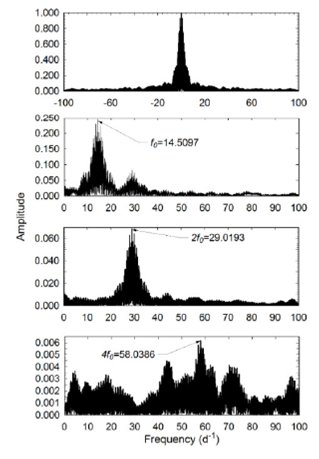
Fig. 7 Spectral window (top panel) and amplitude spectra (f0, 2f0 and 4f0) showing all significant pulsation frequencies following DFT analysis of photometric data from CSS J051053.0+071722 acquired at DBO between 25 Dec 2018 and 25 Jan 2019. This includes the fundamental f0 frequency through its highest partial harmonic 4f0 which was detected (S/N ≥ 6) following prewhitening.
3.3.Global Parameters
Well over 100 years ago Henrietta Leavitt discovered a period-luminosity relationship (PLR) from Cepheid variables in the Small Magellanic Cloud (Leavitt & Pickering 1912) and ever since pulsating stars have endured as standard candles for estimating cosmic distances. This PLR was refined afterwards to reconcile differences between metal rich (Population I) and metal-poor (Population II) Cepheids (Baade 1956). Like Cepheids, other variable stars that pulsate via the κ-mechanism were found to obey distinct PLRs. The earliest PLRs for δ Sct variables were published by Frolov (1969) and Dworak & Zieba (1975). An improvement of the PLR for δ Sct variables was reported by albeit with Hipparcos parallaxes. A new PLR using, for the most part, more accurate values determined by the Gaia Mission (Lindegren et al. 2016; Brown et al. 2018) was recently published . Accordingly this empirically-derived expression (equation 2):
is similar to the equation published by but with improved precision.
Absolute Vmag (MV) was estimated (2.08 ± 0.09) after substituting the fundamental pulsation period (0.0689193 d) into equation 2. The reddening corrected distance modulus (equation 3):
produced an estimated distance (126 3± 54 pc) to CSS J051053.0 + 071722 using
observed values for m (Vavg=12.78 ± 0.01) and AV
(0.20±0.0008). By comparison, the Gaia DR2 parallax-derived distance (Bailer-Jones 2015) reported for this
variable
The pulsation period and temperature/color were measured by direct observation. Similarly, the luminosity (11.28 ± 1.72) can be determined according to equation 4:
when
leads to a mass (1.76 ±0.06Mʘ). Fairly typical for a HADS variable, this result and all others derived from DBO data are summarized in Table 4. Finally, the radius in solar units (R*= 2.17 ± 0.21) was estimated using the well-known relationship (equation 6) where:
TABLE 4 GLOBAL STELLAR PARAMETERS FOR CSS J051053.0+071722*
| Parameter | DBO |
| Mean Teff [K] | 7178 ± 119 |
| Mass [Mʘ] | 1.76 ± 0.06 |
| Radius [Rʘ] | 2.17 ± 0.21 |
| Luminosity[Lʘ] | 11.28 ± 1.72 |
| p[g/cm3] | 0.24 ± 0.07 |
| Log g [cgs] | 4.01 ± 0.07 |
| Q[d] | 0.029 ± 0.002 |
*Using values determined directly from observations at DBO.
Derived values for the density (
where G is the cgs gravitational constant, mʘ =solar mass (g),rʘ =solar radius (cm), M*is the mass and R* the radius of CSS J051053.0+071722 in solar units. Using the same algebraic assignments, surface gravity (log g) was determined by the following expression (equation 8):
The dynamical time that it takes for a p-mode acoustic wave to internally traverse a star is strongly correlated to the stellar mean density. The pulsation constant (Q) is defined by the period-density relationship (equation 9):
where P is the pulsation period (d) and
The full derivation of this expression can be found in Breger (1990). The resulting Q value (0.029 ± 0.002) provided in Table 4 is slightly smaller than what would be expected (Q=0.03-0.04 d) from fundamental radial pulsations observed with other δ Sct variables (Breger & Bregman 1975; Breger 1979; Joshi & Joshi et al. 2015; Antonello & Pastori 2005). It is conceivable that a more extensive dataset collected at multiple sites over a much longer period of time could reveal other oscillation modes that were not detected in this study.
4. Evolutionary status of CSS J051053.0+071722
The evolutionary status of CSS J051053.0+071722 was evaluated (Figure 8) using the PAdova & TRieste Stellar Evolution Code (PARSEC) for stellar tracks and isochrones (Bressan et al. 2021) and then plotted (log Teff vs. log(L/Lʘ) in a theoretical Hertzsprung-Russell diagram (HRD). The thick solid green-colored line defines the zero-age main sequence (ZAMS) position for stars with metallicity Z=0.014. The two broken lines nearly perpendicular to the ZAMS delimit the blue (left) and red (right) edges of the theoretical instability strip for radial low-p modes (Xiong et al. 2016). Also included are the positions of several known HADS and SX Phe-type variables (Balona 2018). The solid black circle indicates the position of CSS J051053.0+071722 using the DBO derived parameters (Teff and Lʘ) provided in Table 4.
Interestingly a single undisputed value for the solar metallicity remains elusive. Over the last few decades, the reference metallicity values used by several authors for computing stellar models have ranged between Z=0.012 and 0.020 (Amard et al. 2019). Investigations still focused on finding a definitive value for Zʘ have been recently reported (von Steiger & Zurbuchen 2016; Serenelli et al. 2016; Vagnozzi 2017). Despite the uncertainty in defining an absolute value for Zʘ, an estimate for metal abundance is required in order to determine the mass, radius and age of CSS J051053.0+071722 from theoretical evolutionary tracks. A Z-value can be estimated indirectly from its Galactic coordinates in that its distance from the galactic plane (-400pc) favors a thick disc membership rather than residence in the halo where metal poor stars ([Fe/H]<-1.6) are found. Furthermore, Qian et al. (2017) report an empirical relationship between metallicity ([ Fe/H ]) and the fundamental pulsation period P for an NDST star according to the following (equation 11)
As expected for a thick disk resident, the predicted value ([Fe/H(] = -0.058 ±0.031) suggests that CSS J051053.0+071722 approaches solar metallicity, or is at most a few times lower.
Two separate PARSEC evolutionary models ranging in age between 1x108 and 2.63x109y are illustrated in Figure 8. The red solid lines show the model tracks (Mʘ=1.70, 1.725 and 1.75) over time when Z=0.020 while the blue, dash-dotted lines define the models (Mʘ =1.35, 1.40 and 1.45) where Z=0.004. The latter simulations correspond to a decrease in metallicity by a factor of 3 to 5 depending on the reference solar metallicity. Assuming Z=0.020, it can be shown that CSS J051053.0+071722 would have a mass of 1.71±0.03 Mʘ and a radius of 2.15 ±0.06 Rʘ. The position of this intrinsic variable near the Mʘ =1.70 evolutionary track extrapolates to an age of 1.24±0.05 Gyr suggesting it is a moderately evolved MS object lying amongst other HADs closer to the blue edge of the instability strip.

Fig. 8 Evolutionary tracks (red solid lines; 𝑍=0.020 and blue dashed lines; 𝑍=0.004) derived from PARSEC models (Bressan et al. 2012) showing position of CSS J051053.0+071722 (black filled circle) relative to ZAMS (thick green line) and within the theoretical instability strip (black dashed lines) for low-order radial mode δ Scuti pulsators. The position of other HADS (*) and SX Phe (open triangle) variables reported by Balona (2018) are included for comparison. The color figure can be viewed online.
By comparison, if CSS J051053.0+071722 is a metal poor (𝑍=0.004) star, then it would
have a somewhat greater radius (2.44 ± 0.02 Rʘ), but would be less
massive (1.40 ±0.02 Mʘ). Its position very close to the 1.4 Mʘ
track lies prior to the HRD region where evolutionary tracks of low metallicity
stars begin stellar contraction near the end of hydrogen burning in the core. This
star would still be a MS object but with an age approaching 2.44±01 Gyr.
Alternatively, an even less massive and smaller (
In summary, the theoretical mass (1.71±0.03 Mʘ) where Z=0.020 favors the higher metallicity of CSS J051053.0+071722 which is also in good agreement with results (1.76 ± 0.06 Mʘ) independently determined using an empirical mass-luminosity relationship. If or when high resolution spectroscopic data become available in the future, uncertainty about the mass and metallicity of CSS J051053.0+071722 will likely decrease.
5. Conclusions
This first multi-color (BVIc) CCD study of CSS J051053.0+071722 has produced 36 new times-of-maximum. Due to the short duration and lack of other published ToMax values, no attempt was made to evaluate secular changes in the fundamental mode of oscillation. Deconvolution of time-series photometric data by discrete Fourier transformation shows that this star is a monoperiodic radial pulsator (f0=14.5097 d-1) which also oscillates in at least 2 other partial harmonics (2f0 and 4 f0). A mean effective temperature for CSS J051053.0+071722 (7178 ±119 K) was estimated from a composite of Gaia DR2, 2MASS and DBO results which likely corresponds to spectral type A9-F2. The pulsation period (≈ 0.068919 d), radial oscillation mode, Vmag amplitude (0.43 mag), spectral type and LC morphology are all consistent with the defining characteristics of a HADS variable. It should be noted that these attributes do not necessarily exclude the possibility that CSS J051053.0+071722 is a field SX Phe-type variable. However, the generally accepted threshold for SX Phe stars is < 1.3 Mʘ ( 2011) which in this case is far less than the mass predicted from a M -L relationship (≈1.76 Mʘ) and evolutionary modeling (≈1.71Mʘ). Given these results, the weight of evidence confirms the classification of CSS J051053.0+071722 as a HADS variable.
This research has made use of the SIMBAD database operated at Centre de Données astronomiques de Strasbourg, France. In addition, the Northern Sky Variability Survey hosted by the Los Alamos National Laboratory, the All Sky Automated Survey Catalogue of Variable Stars and the Catalina Surveys Data Release 2 archives were mined for essential information. This work also presents results from the European Space Agency (ESA) space mission Gaia. Gaia data are being processed by the Gaia Data Processing and Analysis Consortium (DPAC). Funding for the DPAC is provided by national institutions, in particular the institutions participating in the Gaia MultiLateral Agreement (MLA). The Gaia mission website is https://www.cosmos.esa.int/gaia while the Gaia archive website is https://archives.esac.esa.int/gaia. The careful review and helpful commentary provided by an anonymous referee is gratefully acknowledged.











 nueva página del texto (beta)
nueva página del texto (beta)


